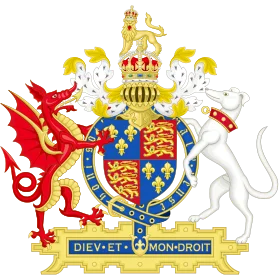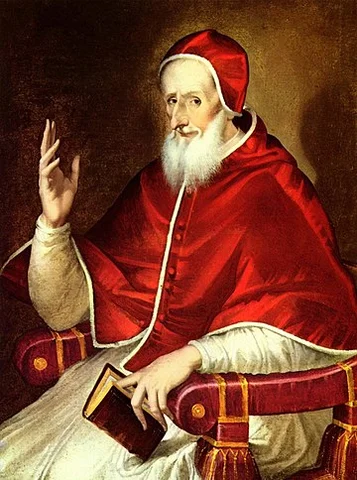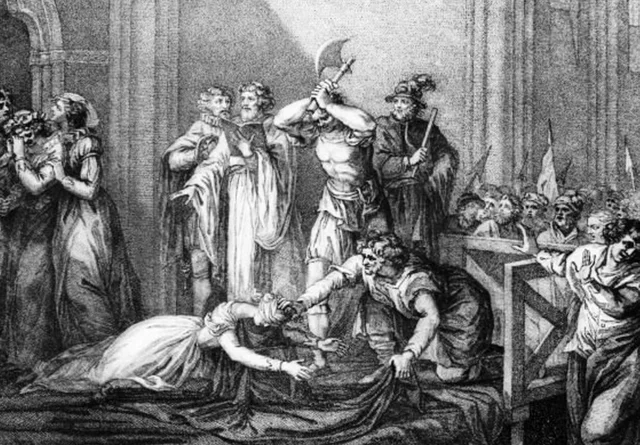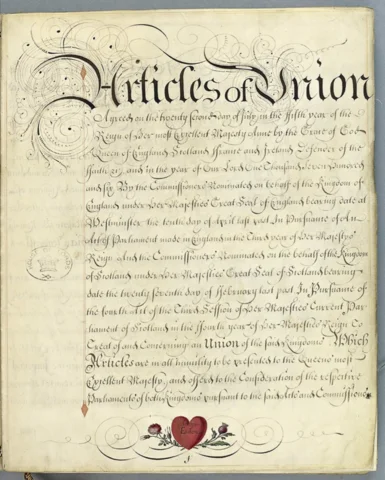-
Henri VIII became the King at only 17 years old, following the death of his father Henri VII (1st Tudor King)
-
 Henri VIII is hereby declared as the Supreme Head of the Church of England. This act marks the separation of the Church of England from the Rome Catholic Church.
Henri VIII is hereby declared as the Supreme Head of the Church of England. This act marks the separation of the Church of England from the Rome Catholic Church. -
Son of Henri VIII and Jane Seymour. During his reign, he took measures which pushed England toward Protestantism. He died at 15, leaving the country virtually bankrupt.
-
 Revision of the mass-book which dictates how prayers, masses and many other core part of the Church should go (based on Protestant practices).
Revision of the mass-book which dictates how prayers, masses and many other core part of the Church should go (based on Protestant practices). -
Mary I was the daughter of Henri VIII and Catherine of Aragon (his first wife). Fiercly catholic, she restored Catholicism in only 18 months. She is also known as "bloody mary" for her violent repression of Protestants.
-
Elizabeth I became the Queen of England at 25 years old following the death of Mary I. She reigned for 45 years before dying at 65 years old, without a husband nor an heir.
-
 Every parish had to use the Book of Common Prayer. A fine of 20£ was created for those who did not attend Anglican services. Being Catholic was not illegal, but it was mandatory to attend.
Every parish had to use the Book of Common Prayer. A fine of 20£ was created for those who did not attend Anglican services. Being Catholic was not illegal, but it was mandatory to attend. -
 Abolished again the authority of the Pope previously restored by Mary I. This act restored the authority of the Queen over the Church, making her the Supreme Governor of the Church of England.
Abolished again the authority of the Pope previously restored by Mary I. This act restored the authority of the Queen over the Church, making her the Supreme Governor of the Church of England. -
This statement brings 3 new changes to the doctrine of the Church : a new ecclesiology, new doctrine of Salvation and a new definition of sacraments.
-
 The Pope published a Papal Bull in which he refers to Elizabeth I as a "so-called Queen", not recognizing her as a full monarch. He declares her a heretic, and as such gives the right to Catholics to kill her.
The Pope published a Papal Bull in which he refers to Elizabeth I as a "so-called Queen", not recognizing her as a full monarch. He declares her a heretic, and as such gives the right to Catholics to kill her. -
 This act declares that converting to Catholicism or already being converted is punishable by the death penalty. It forbids the participation in any Catholic practice and install a fine of 20£ for not attending Anglican services.
This act declares that converting to Catholicism or already being converted is punishable by the death penalty. It forbids the participation in any Catholic practice and install a fine of 20£ for not attending Anglican services. -
 Mary queen of Scots or Mary Stuart was executed as she represented a threat to the Queen Elizabeth I.
Mary queen of Scots or Mary Stuart was executed as she represented a threat to the Queen Elizabeth I. -
 Failed atempt at invading England by the King of Spain Philip II. He was already an enemy of Elizabeth I by supporting plots against her, but it is when she decided to join Dutch forces against Spain that he planned to invade England. He failed since England's boats were quicker than his armada.
Failed atempt at invading England by the King of Spain Philip II. He was already an enemy of Elizabeth I by supporting plots against her, but it is when she decided to join Dutch forces against Spain that he planned to invade England. He failed since England's boats were quicker than his armada. -
James I was crowned king of Scotland in 1567 before becoming King of England at the death of Elizabeth I in 1603. Son of Queen Mary of Scots, James was a strong believer in the divine rights of kings.
-
 A conspiracy by a small Catholic group to blow up parliament and assassinate James I.
A conspiracy by a small Catholic group to blow up parliament and assassinate James I. -
Firm believer in the divine rights of kings, he established during his reign the "presonal rule" making him the sole governor for 11 years. His reign was qualified by Whig historians as "the eleven years of tyranny". After putting the country in so much trouble that he had to call back parliament, Charles I was executed in 1649 (after the English Civil Wars).
-
1637: the introduction of the New Prayer Book
(Book of Common Prayer) set Scotland aflame.
The changes were deemed unacceptable. The Scots issued a petition against Charles II and removed the bishops. Viewing this action as rebellion Charles II threatened Scotland. Both Scotland and England formed armies (Bishop War). Scotland invaded England and won, resulting in a peace treaty (Treaty of Ripon, October 1640) where Charles II had to pay for the Scots' army costs. -
 A document voted by Parliament which summarized all of Charles I's wrongdoings. It concluded on "revolutionary" demands. This document lead to the division of Parliament, with Parlimentarians who found the reform necessary and Royalists who were in favour of the King.
A document voted by Parliament which summarized all of Charles I's wrongdoings. It concluded on "revolutionary" demands. This document lead to the division of Parliament, with Parlimentarians who found the reform necessary and Royalists who were in favour of the King. -
Charles I declared war on Parliament on the 22nd of august in 1642.
The first war lasted four years (1642-46) and opposed Parlimentarians and Royalists. This war ended with the victory of Parlimentarians, who then created a new model army, signed an alliance with Scotland and so on.
The second war lasted from 1648 to 1649, after the King escaped and made an alliance with the Scots.
Charles I was executed after being tried for high treason. -
Following the regicide of Charles I, England declared a Commonwealth (governed by the people without a king). The monarchy and the House of lords were abolished in March 1649, which led to England declaring the Commonwealth which acts as a Republic. During the Interregnum, many atempts were made at a republican form of government.
-
A military dictatorship ruled by Cromwell, auto-proclaming himself "Lord Protector". This dictatorship included the re-election of 460 MPs every 3 years, a council of state and the first and only England's written constitution : The Instrument of Government. Cromwell's death in 1658 resulted in his son Richard to become Lord Protector before resigning, leading to an Anarchy.
-
 Charles II issued the Declaration of Breda and restored the Monarchy in 1660.
Charles II issued the Declaration of Breda and restored the Monarchy in 1660. -
Period of tensions between the Parliament and the King. Repressive religious legislations being passed : The Clarendon Code. Additionally, Charles II encountered many disasters during his reign such as : the Plague (1665), the Great Fire of London (1666) and faced opposition and hostility from the people.
-
The Popish Plot of 1678 : a plot organized by the French to muder Charles II and replace him with his Catholic brother James II.
The Exculsion crisis (1679-1681) : Parliament attempted to debar James II from the succession to the English throne. Charles II then dissolved the Parliament. James was supported by the Tories while Charles was supported by the Whigs. -
 James II being catholic increased the fear of reverting to the Civil Wars era. His second wife giving birth to a son was a direct threat to Protestantism and Parliament's power. As prevention, the Parliament's allowed William of Orange to invade England and seize the crown. The invasion was a success : James II fled to France and William became King William III. He became joint monarchs with his wife. England became a constitutional Monarchy with the Bill of Rights limiting their power.
James II being catholic increased the fear of reverting to the Civil Wars era. His second wife giving birth to a son was a direct threat to Protestantism and Parliament's power. As prevention, the Parliament's allowed William of Orange to invade England and seize the crown. The invasion was a success : James II fled to France and William became King William III. He became joint monarchs with his wife. England became a constitutional Monarchy with the Bill of Rights limiting their power. -
 William III died in 1702. Succeeded by Anne (last Stuart monarch), then by George I (1714).
William III died in 1702. Succeeded by Anne (last Stuart monarch), then by George I (1714). -
 The first Act of Union marking the creation of the United Kingdom of Great Britain (and Wales) and Scotland.
The first Act of Union marking the creation of the United Kingdom of Great Britain (and Wales) and Scotland. -
 The second Act of Union expanded the United Kingdom of Great Britain to Ireland.
The second Act of Union expanded the United Kingdom of Great Britain to Ireland.